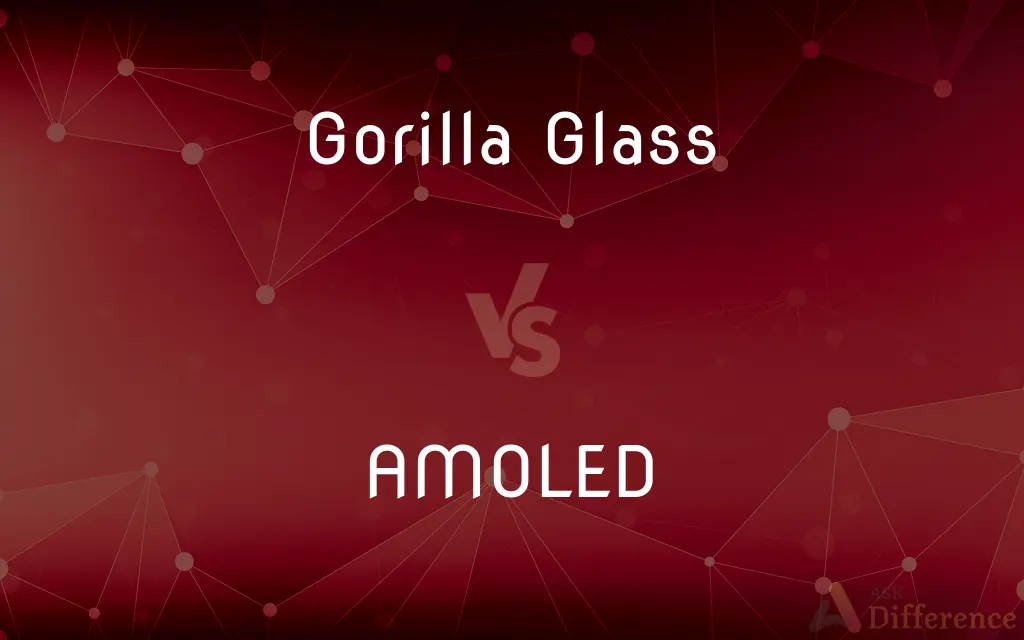Gorilla Glass vs. AMOLED — What's the Difference?
By Tayyaba Rehman — Published on October 21, 2023
Gorilla Glass is a durable, scratch-resistant glass used in electronics, while AMOLED is a display technology offering vibrant colors and deep blacks.

Difference Between Gorilla Glass and AMOLED
Table of Contents
ADVERTISEMENT
Key Differences
Gorilla Glass, developed by Corning, is renowned for its exceptional strength and durability. It is a type of chemically-strengthened glass that undergoes a unique process to increase its scratch and damage resistance. AMOLED, standing for Active Matrix Organic Light Emitting Diode, represents a type of screen technology. Its distinct feature is that it lights up individual pixels when necessary, resulting in vibrant colors and true black representation.
The design intention behind Gorilla Glass is to protect electronic devices from everyday wear and tear. It has undergone multiple iterations, with each new version aiming to be stronger and more resistant to scratches and drops. On the other hand, AMOLED screens are favored for their energy efficiency and superior contrast ratios. Because each pixel is individually lit, AMOLED can turn off certain pixels entirely, rendering a perfect black.
In the world of smartphones, tablets, and other electronic devices, it's not uncommon to find devices featuring both Gorilla Glass and AMOLED. Gorilla Glass serves as the protective outer layer, shielding the device's screen. Beneath it, the AMOLED display presents visuals in rich, vivid detail. It's essential to understand that while Gorilla Glass pertains to physical protection, AMOLED concerns visual display and quality.
Lastly, when choosing devices, users often look for Gorilla Glass for assurance against scratches and accidental drops. In contrast, those keen on visual experience might gravitate towards devices with AMOLED displays, valuing their color accuracy, and deep black levels.
Comparison Chart
Primary Function
Protective layer for devices
Display technology for screens
ADVERTISEMENT
Development
By Corning Incorporated
Based on OLED technology
Feature
Scratch and damage resistance
Vibrant colors and true blacks
Application
Exterior screen protection
Visual display beneath the protective screen
Key Benefit
Durability against drops and scratches
Energy efficiency and superior contrast
Compare with Definitions
Gorilla Glass
A chemically-strengthened glass for electronics.
The smartphone features the latest Gorilla Glass for enhanced durability.
AMOLED
Each pixel is individually lit for efficiency.
With AMOLED, the black backgrounds are truly pitch-black.
Gorilla Glass
Developed by Corning Incorporated.
Corning's Gorilla Glass is a popular choice for high-end devices.
AMOLED
Delivers superior contrast ratios in displays.
For cinematic experience, AMOLED screens are often recommended.
Gorilla Glass
Known for scratch and damage resistance.
Thanks to Gorilla Glass, my phone survived the fall without a scratch.
AMOLED
Known for vibrant colors and true blacks.
AMOLED displays are preferred for their vivid color reproduction.
Gorilla Glass
Has multiple versions with increased strengths.
Each iteration of Gorilla Glass aims to offer better protection.
AMOLED
Offers energy-efficient screen technology.
Choosing an AMOLED screen can save battery life.
Gorilla Glass
Used as a protective screen layer.
The tablet is fortified with Gorilla Glass to withstand daily use.
AMOLED
A display technology based on organic light-emitting diodes.
The AMOLED screen on my phone delivers stunning visuals.
Common Curiosities
Why is AMOLED known for its colors?
AMOLED can produce vibrant colors and true blacks since each pixel is individually lit.
How does AMOLED function?
AMOLED uses organic compounds to light up individual pixels on display, offering vibrant colors and deep blacks.
Which company developed Gorilla Glass?
Gorilla Glass was developed by Corning Incorporated.
How has Gorilla Glass evolved over the years?
Gorilla Glass has seen multiple versions, each with enhanced strength and damage resistance.
What is Gorilla Glass?
Gorilla Glass is a type of durable, scratch-resistant glass used primarily in electronics.
Can Gorilla Glass prevent all screen damages?
While Gorilla Glass offers significant protection, extreme impacts can still cause damage.
How does AMOLED compare to LCD?
AMOLED offers better contrast and color vibrancy, while LCD might offer better brightness in some cases.
Is Gorilla Glass unbreakable?
While Gorilla Glass is strong and scratch-resistant, it is not entirely unbreakable.
Which devices commonly use Gorilla Glass?
Smartphones, tablets, and some TVs use Gorilla Glass for protection.
Does AMOLED consume more power than other displays?
AMOLED can be more energy-efficient, especially when displaying dark visuals, as it can turn off individual pixels.
Why are the blacks on AMOLED screens so deep?
AMOLED can turn off pixels entirely, producing true blacks.
Do all high-end devices use Gorilla Glass?
Many high-end devices use Gorilla Glass, but there are also other types of protective glasses available.
What's the primary advantage of AMOLED?
AMOLED offers superior contrast ratios, energy efficiency, and color vibrancy.
Is AMOLED the same as OLED?
AMOLED is based on OLED technology but has an active matrix controlling individual pixels.
Is Gorilla Glass resistant to smudges and fingerprints?
Gorilla Glass has oleophobic coatings to reduce smudges, but it's not entirely immune to fingerprints.
Share Your Discovery

Previous Comparison
Cavern vs. Cove
Next Comparison
Shall Be vs. Would BeAuthor Spotlight
Written by
Tayyaba RehmanTayyaba Rehman is a distinguished writer, currently serving as a primary contributor to askdifference.com. As a researcher in semantics and etymology, Tayyaba's passion for the complexity of languages and their distinctions has found a perfect home on the platform. Tayyaba delves into the intricacies of language, distinguishing between commonly confused words and phrases, thereby providing clarity for readers worldwide.
















































